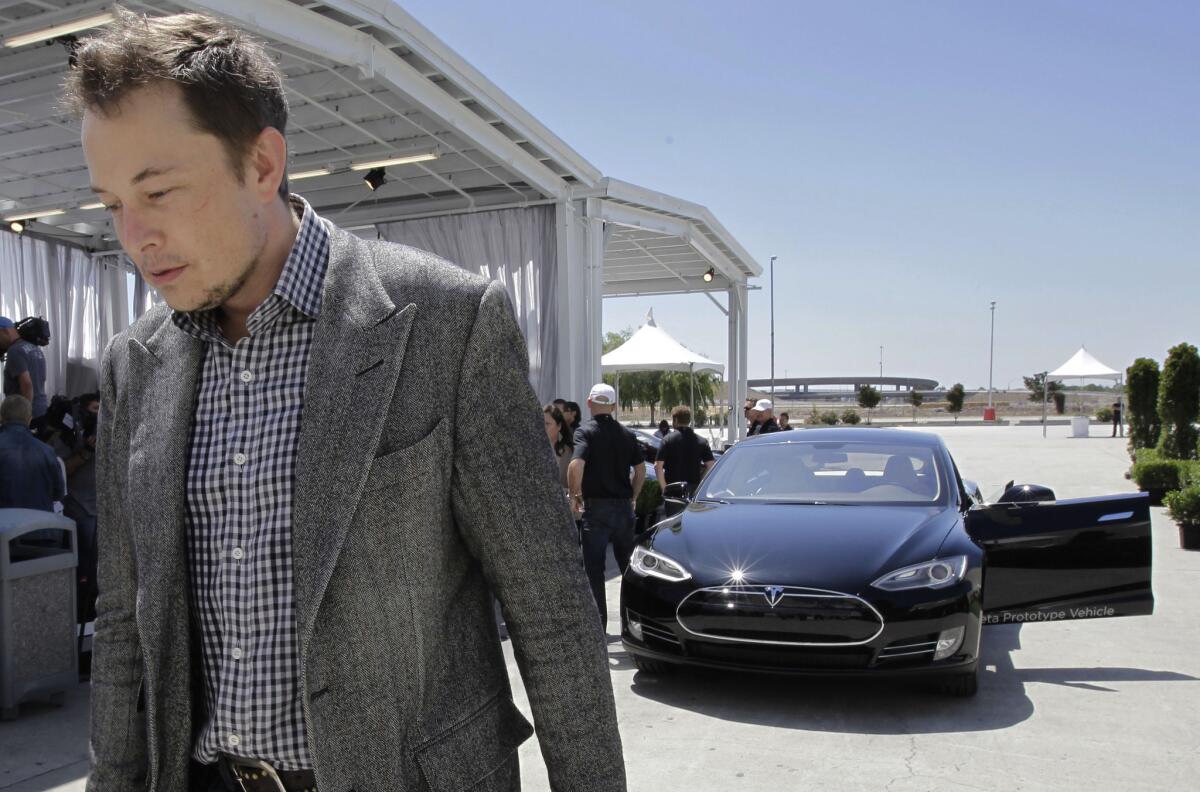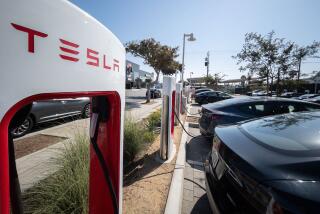Tesla plugs into new markets with batteries for electricity storage

Billionaire Elon Musk’s Tesla Motors Inc. is expected to announce next week that it will expand into a new business offering battery-based energy storage for residential and commercial customers.
Documents filed with the California Public Utilities Commission show that Tesla already has launched pilot projects that leverage technology it has developed for electric car batteries to create a way for homeowners and businesses to store power.
The Palo Alto automaker is scheduled to collect $65 million in state incentives for its projects under the advanced storage technology portion of the PUC’s Self-Generation Incentive Program, according to Terrie Prosper, a spokeswoman for the agency.
The electric car company has started to brief environmental groups and analysts on its plans. Retailing giant Wal-Mart Stores Inc. confirmed that it is participating in the test programs and expects to purchase more Tesla battery systems.
SolarCity, a solar energy company, has installed Tesla batteries at several Wal-Mart sites in California “to help manage peak energy demand, and will likely be adding more in the coming years,” said Kevin Gardner, a Wal-Mart spokesman.
Tesla Chief Executive Musk is also the chairman of San Mateo, Calif.-based SolarCity.
Last month, Musk said on Twitter that he would announce a new product line — not a car — on Thursday, but has not elaborated. The announcement will be made at the automaker’s design center in Hawthorne.
“We’ll have more to share next week,” spokeswoman Khobi Brooklyn said.
Storing electricity efficiently, inexpensively and safely is a problem that has vexed the power industry since electricity was first harnessed. But such storage has huge implications for bolstering the national electricity grid and reducing pollution from power generation.
Homeowners and businesses, for example, could charge batteries at night, when there is surplus generation and rates are cheap, and then use the power during the day, when there is a heavy load on the grid and rates are highest.
“You can look at the battery as an asset on the grid and then you can start to figure out the financial opportunities,” said Rajit Gadh, director of UCLA’s Smart Grid Energy Research Center.
Tesla’s strategy is designed to leverage a planned $5-billion investment by the car company, battery cell manufacturer Panasonic and other partners in a massive lithium-ion battery “gigafactory” under construction near Reno.
Musk has said the factory will slash the cost of producing batteries about 30% and is crucial to the automaker’s plans to introduce a small electric family sedan that will sell in the $30,000 range after government rebates and incentives. Tesla is looking for other profitable ways to tap production from the plant.
“The gigafactory is a big play for the whole energy world,” said Max Baumhefner, an attorney with the Natural Resources Defense Council who was briefed by the automaker.
A steady increase in solar- and wind-generated power is increasing the need to develop efficient electricity storage systems, Baumhefner said. That’s because generation from such sources can be almost limitless and needs to go somewhere.
Using dedicated battery systems as well as storage derived from electric vehicle batteries that are no longer strong enough for automotive use but still have life “makes a lot of sense,” he said. There already are enough batteries operating in the nation’s small electric car fleet to power all the homes in a city the size of Washington for a day, Baumhefner said.
Other automakers, including BMW, have launched electric vehicle battery storage pilot programs in California. One BMW program pays electric car drivers to time their charges to periods that even out the load on the grid. It also has a bank of spent EV batteries in Mountain View, Calif., that it charges with solar power and uses to feed power into the grid at peak times.
Spending on microgrid projects — which encompass a variety of energy generation and storage technologies — in the U.S. is poised to grow to $19.9 billion in 2020 from $4.3 billion in 2013, according to Navigant Research.
In December, the PUC held a workshop to craft energy storage and interconnection rules. One of the panelists was Mateo Jaramillo, director of powertrain business development at Tesla Motors. Another was Ryan Hanley, director of grid engineering solutions at SolarCity.
During the presentation Jaramillo outlined several Tesla pilot projects for using grid-connected batteries to store electricity.
He discussed the differing requirements among major utilities for telemetry requirements — the way large battery storage systems communicate with the grid to prevent power surges and gaps — and suggested low-cost options.
Baumhefner said, “Tesla is looking to get into energy storage whether it is on four wheels or stationary.”
Follow me on Twitter (@LATimesJerry), Facebook and Google+.







